Those who feel like going or returning to see, between now and the end of the month, the large cycle that Anselm Kiefer has executed for the Scrutiny Room of the Ducal Palace, might attempt an exercise: Record the comments of visitors who, having passed the Sala del Maggior Consiglio, first linger in the Sala della Quarantia Civil Nuova, where Kiefer has set up a kind of introibo to the major installation, and then swarm into the adjoining room, and stand before the German artist’s terrible visions. What will come out is a mosaic of adjectives in all languages that will mainly account for the visual power of These writings, when burned, will finally give some light (this is the title of the work, a quote from the philosopher Andrea Emo Capodilista): “thrilling,” “apocalyptic,” “enthralling,” “imposing,” “extraordinary,” “grandiose.” Some call it an “immersive experience,” the locution usually used to refer to those shows of video projections and musical backgrounds that try to move the works of a Caravaggio or a Van Gogh. It is difficult, if not impossible, for the perhaps more fitting term to be uttered: “distressing.” Some will perhaps go so far as to feel a little disquiet, but it is difficult for this impression to be transformed into the sense of oppression that springs from the existential questions raised by Kiefer’s art.
Since there is no single truth, no objective truth (and in this sense Kiefer’s art takes on the contours of a counterpart in images to Andrea Emo’s thought, where the philosopher wrote that “truth is always double and ambiguous” and that “nothing is less sincere, simple, unambiguous, identical, and self-evident than truth”), neither can there be an unambiguous interpretation for his works: Matthew Biro has pointed out that the hermeneutic undecidability of Kiefer’s works, an inevitable consequence of the thinking that has always animated his art, suggests that for the German artist any definition of the world needs to be “tempered by debate with others in his own community”, and that consequently “art can only inspire a discussion that will lead to the concept of a possible collective subject, and cannot produce a subject per se.” Rather, it is from the conflict of interpretations that the work, according to Kiefer, comes to construct a public sphere. In the Hall of Scrutiny, Kiefer’s ambiguity operates through the translocation of the history of Venice: the texts that Janne Sirén, curator of the exhibition together with Gabriella Belli, prepared to describe the eight monumental works arranged along the sides of the room narrate a “Cycle of Venice” that one would like without a definite beginning or end, but they facilitate a reading that starts from an uninhabited lagoon, a refuge for the first fishermen who settled here in late antiquity, passes through moments of glory, opulence and wealth (the shopping carts, the cards inform us, are a metaphor for the succession of doges, and then we see submarine shapes evoking the ships that starting from the city ploughed the Adriatic, and again the profile of the Doge’s Palace, the banner of the Lion of St. Mark garrulous in the wind), and passing also through the modern Venice of tourists (near the Doge’s Palace we see the profiles of backpacking travelers) arrives at a kind of final epiphany that, in complete abstraction, “depicts nothing and everything.”
In Kiefer’s art there has always existed an indissoluble link between destruction and creation, which the not-new juxtaposition with Andrea Emo has made more evident. The Venetian philosopher wrote that “the ars magna, which is the pattern of all art, of all faith, of all wisdom, is the destruction of images - of the images of which we are prisoners when we are but the mirror of them and which rise again as the image of our liberation when we have destroyed them.” The same quotation placed at the title of the exhibition recalls a well-known fragment of Heraclitus (“This universal order, which is the same for all, was not made by any among the gods or among men, but always was, is and will be living fire, which is kindled and extinguished according to right measure”) where central is the element of fire, also dear to Andrea Emo, a mutable and constant entity, and according to Heraclitus the principle of all things. In making fire the founding element of his installation, Kiefer, in addition to making the obvious reference to the fire that destroyed this portion of the Doge’s Palace in 1577 and led to the creation of the new decorations of the Sala del Maggior Consiglio (from those flames came one of the most impressive masterpieces of modern art, Tintoretto’s Paradise ) and of the Scrutiny Room itself, he also intends to point out to himself and the public some important problems of artistic creation, which include the dimensions of negation and transformation.
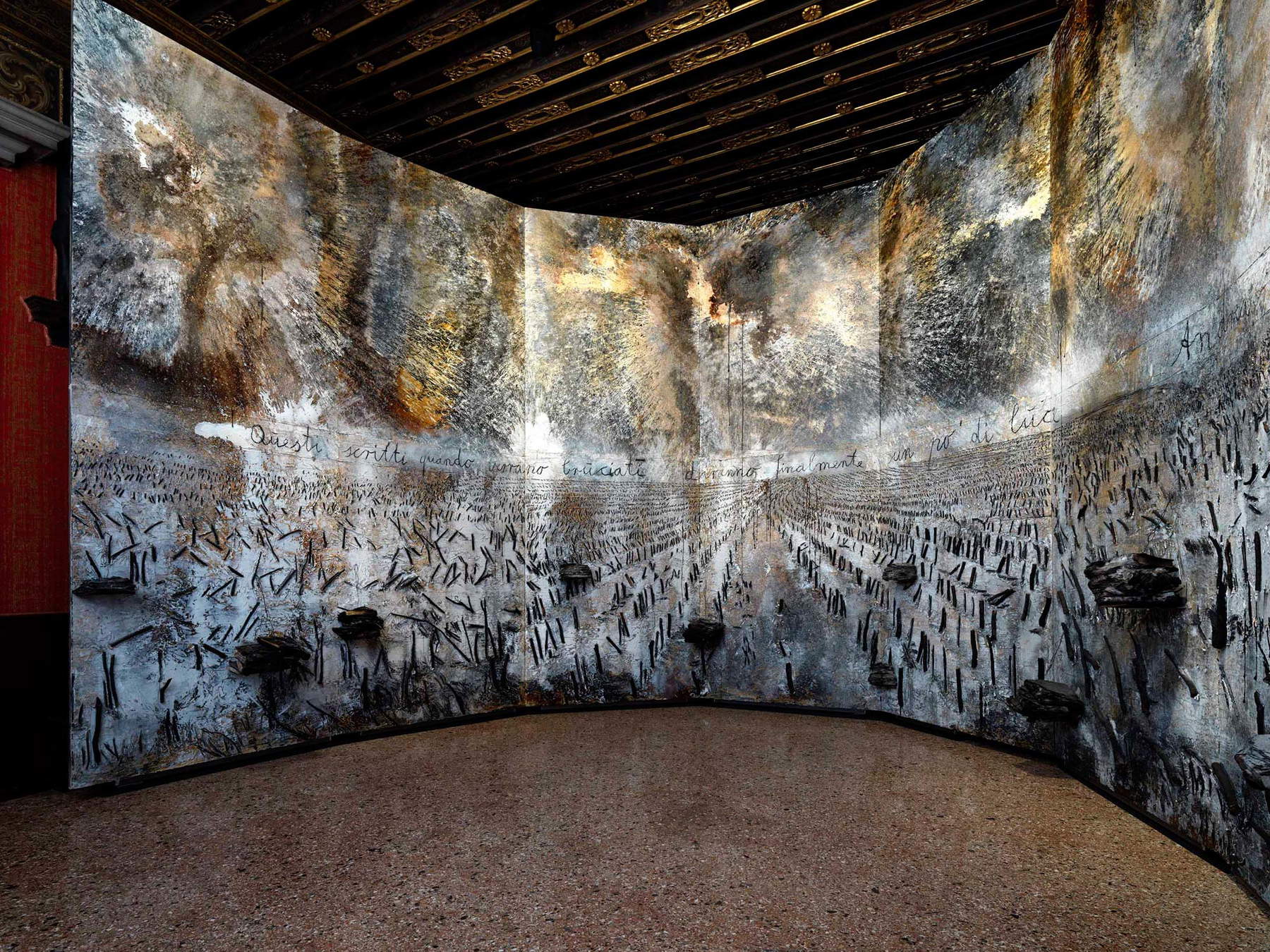
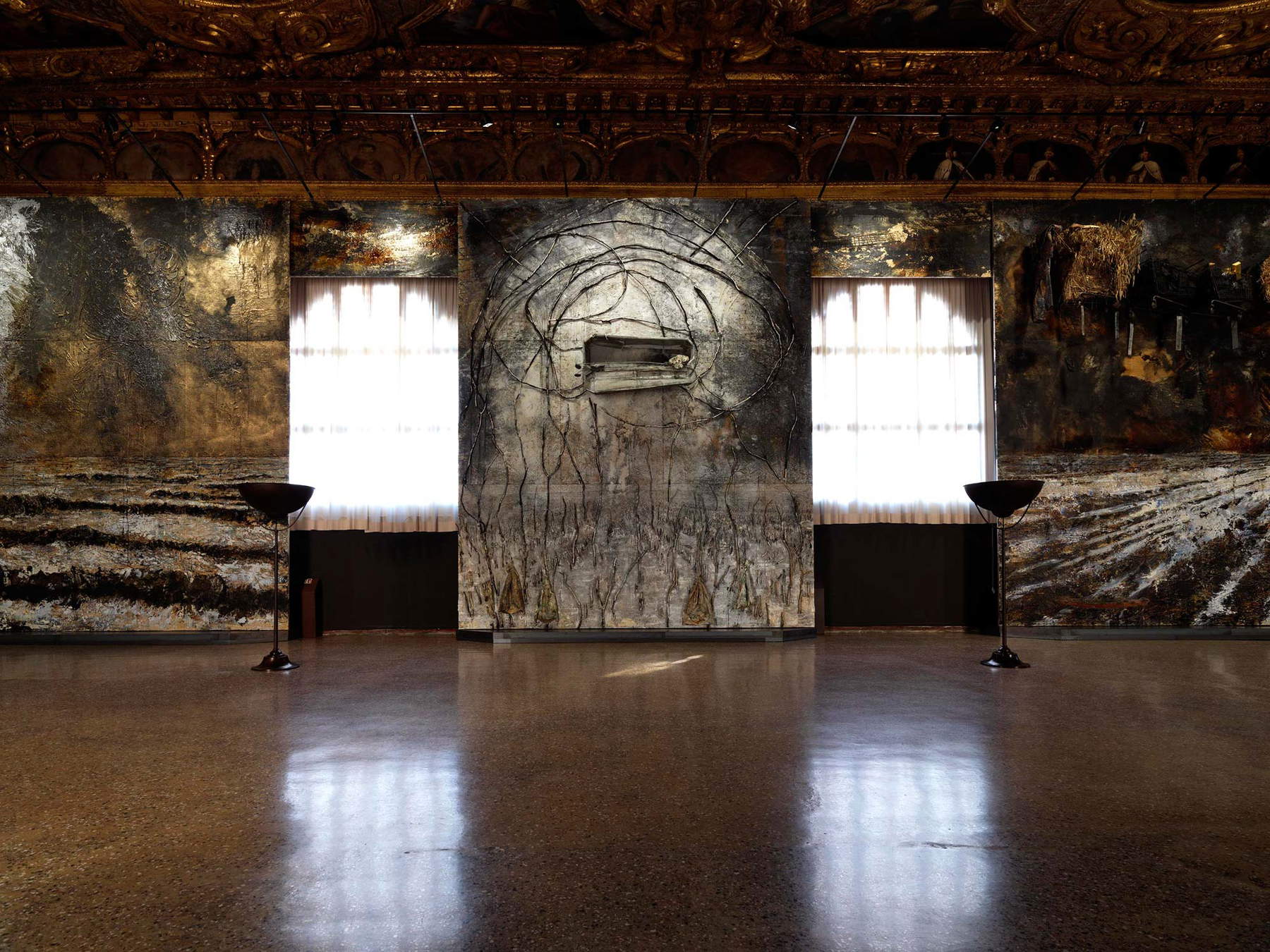
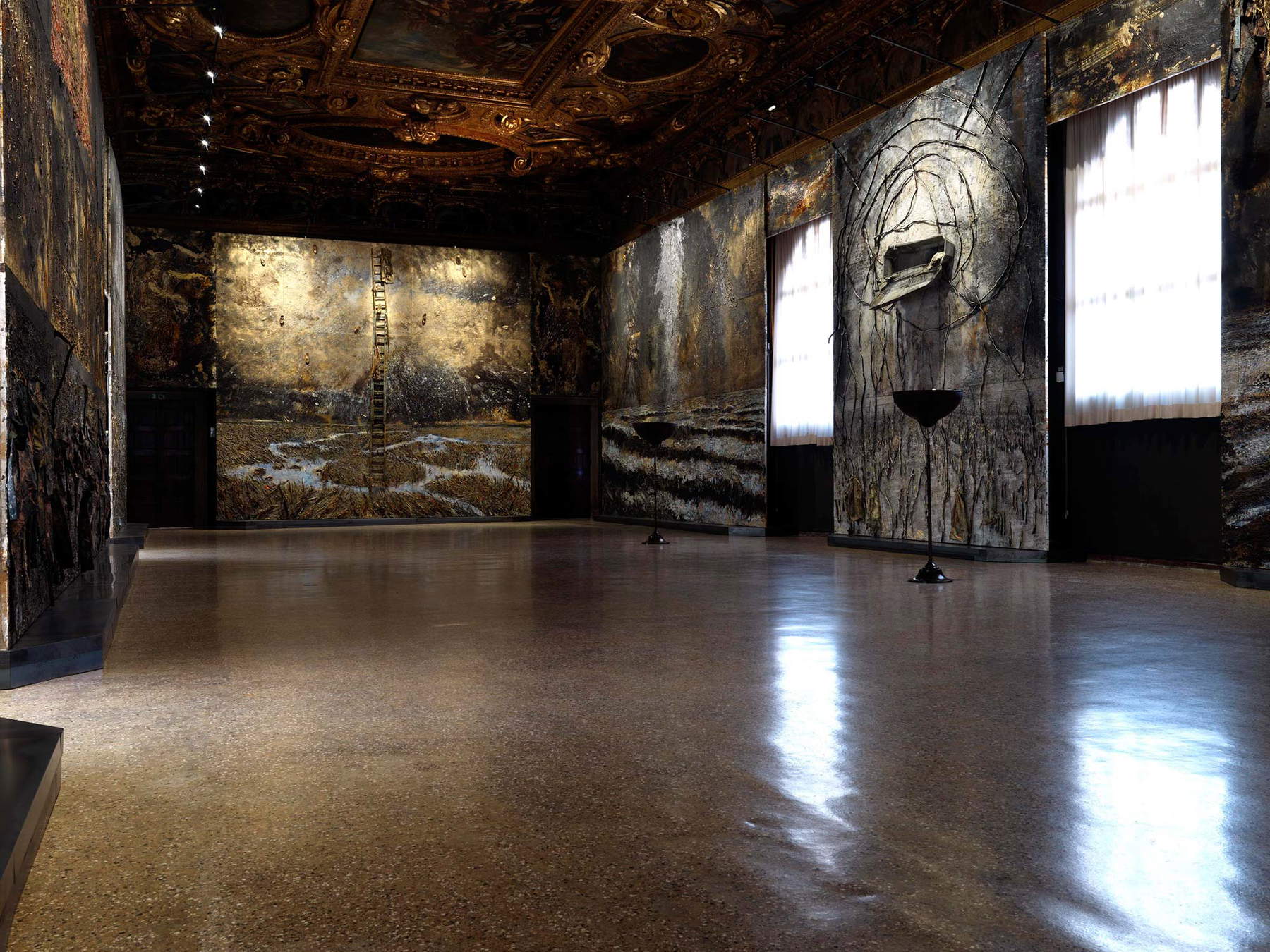
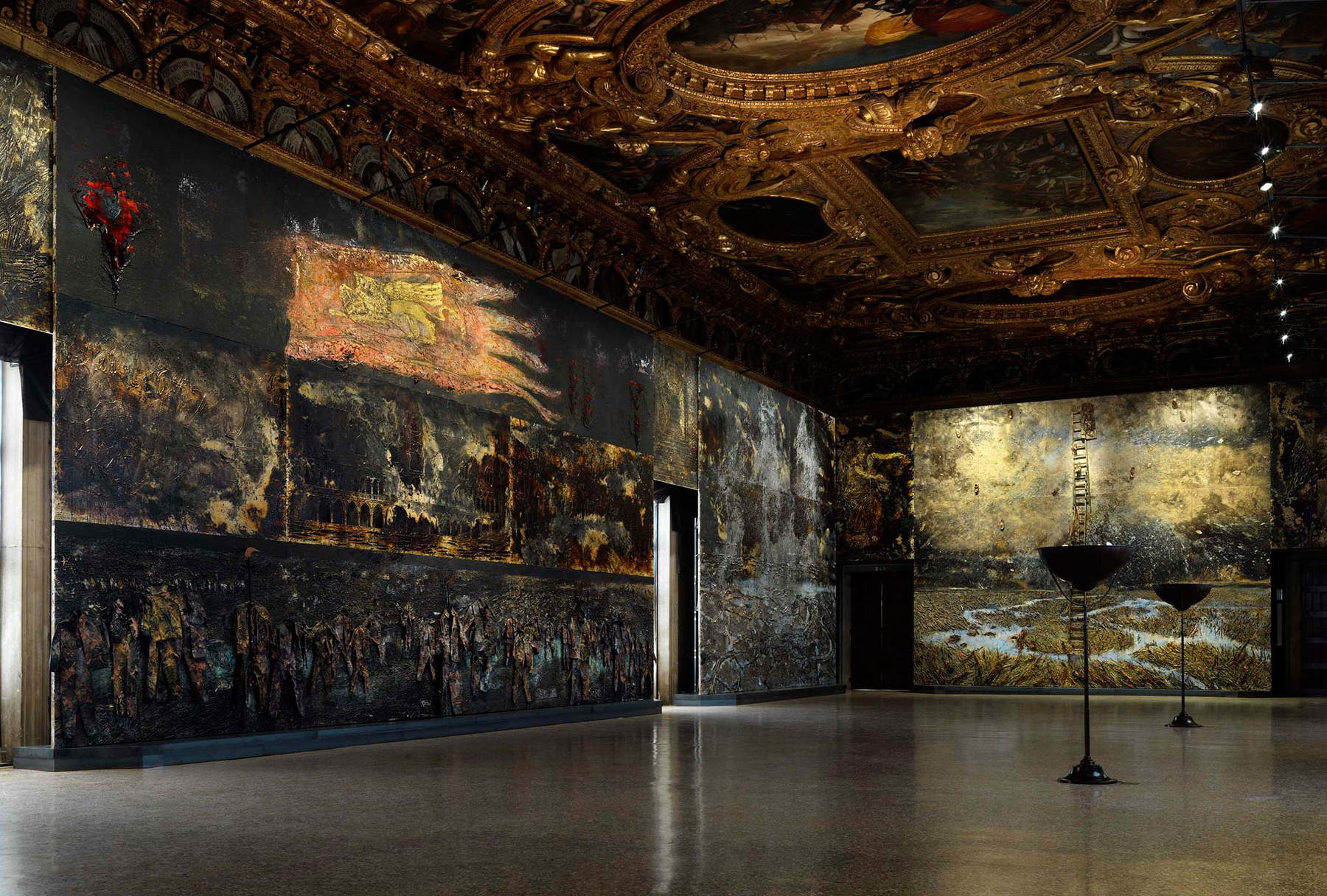
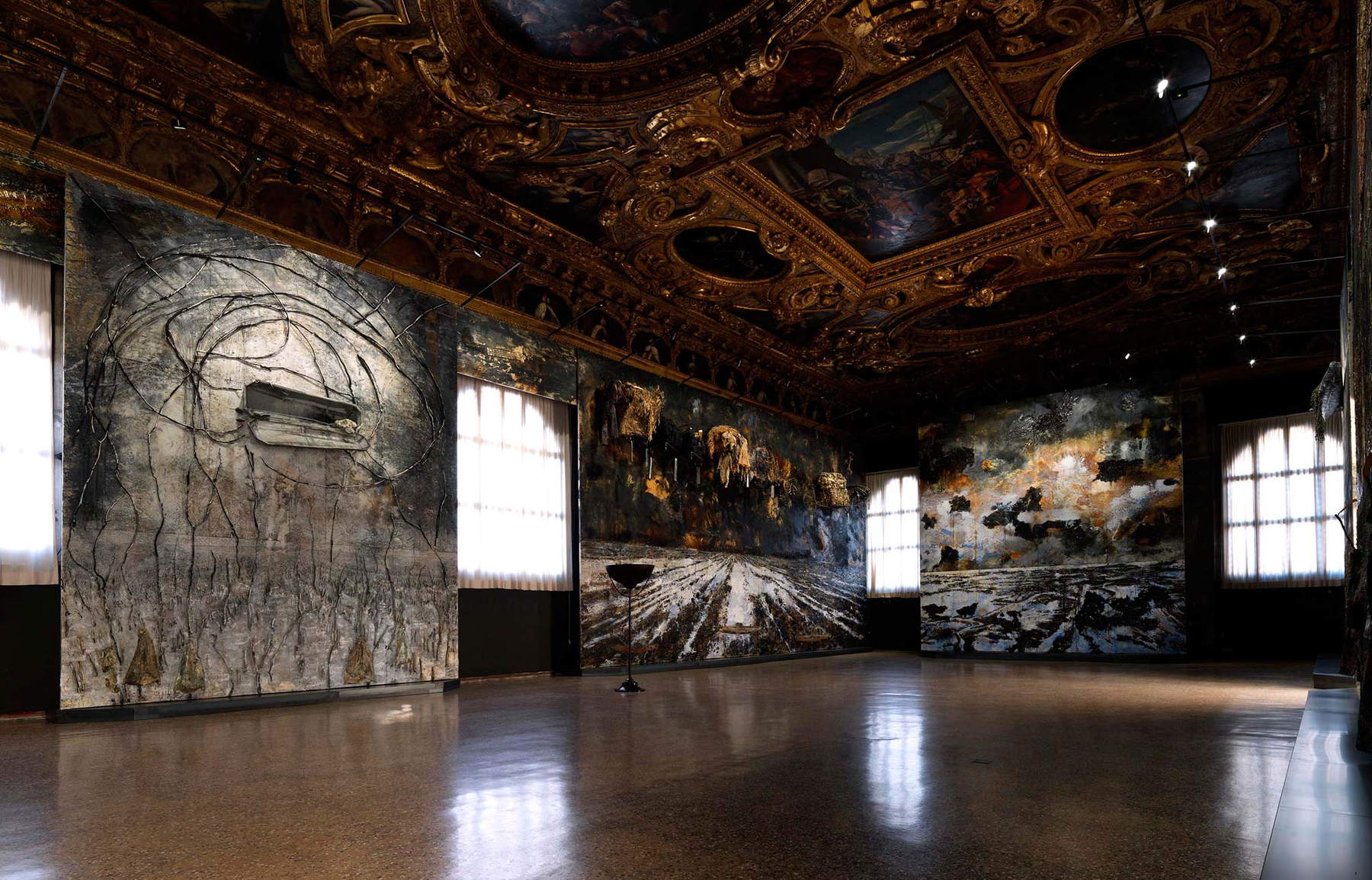
This is the reason why Kiefer’s works appear, one might say, as the negation of themselves. Here and there elements that emerge from an earlier drafting appear as if trapped by the gross superfetations that Kiefer continually adds to what he had elaborated before. Sometimes the surface of the paintings (assuming it is possible to consider them as such) appears oxidized to the point of obstructing the view of everything that existed before. The images themselves are faded, worn, ghostly: the shadow of the Doge’s Palace, the torn banner, the procession of the dead, a sum of motifs that, Janne Sirén suggests to the audience, represents the most immediate emphasis of Kiefer’s nihilistic view of history, a continuous cycle of the rise and fall of civilizations. Still referring to Emo: “Metamorphosis is always a transformation in form. All our life operates in this sense, and history seems to have this purpose of the transformation of the real into form; all our life is a metamorphosis. Metamorphosis is not the transition from one form to another, but the transition from the formless, from the immediate, to form.” This is the process to which Kiefer has tried to give form in the rooms of the Doge’s Palace, a continuous cycle of birth, transformation, and regeneration that originates from pure matter and inexorably perishes by passing through different stages.Applying this thought to the history of Venice means, for Kiefer, to place himself in a critical attitude towards the past (and also the future). An attitude not without ambiguity at a time when the German artist’s dialectic constantly oscillates between destruction and generation. And, finally, an attitude we do not discover in the Hall of Scrutiny. If it is true what Emo himself said, namely that there is no novelty except in memory and that the new is born when we know how to renounce the new, then with a hint of irony it will be necessary to point out that it is in the absence of novelty that lies the most interesting, intimately philosophical and supremely coherent result of Kiefer’s cycle.
We find in the Ducal Palace cycle elements that have been raging in Kiefer’s art since at least the 1970s. The scorched, desolate fields with the lofty horizons contrived to capture the viewer and suggest to him the feeling that he is moving within Kiefer’s world (a feeling that, Biro wrote again, “creates a strong sense of ’place’ or ’positioning’ in relation to the field described in the painting and thus potentially engenders awareness on the part of the viewer”). The idea of a landscape on which elements intervene and transform it until it dissolves into nothingness, as happened in a 1974 work, Ausbrennen des Landkreises Buchen, and where, moreover, the element in question was precisely fire. A landscape of ruins where Kiefer presents himself, paradoxically, “both as the source and the object of an aesthetic violence” (Biro again). The images themselves bring to mind the series of works Kiefer had exhibited in 2018 at Thaddaeus Ropac in Paris for the exhibition Für Andrea Emo: intricate landscapes of dry branches, wood, resin, objects, straw, and ash with assorted virtuosities (such as brushstrokes suggesting the fluid movement of water) were lined up in the large shed in Pantin, on the outskirts of the French capital, to translate Andrea Emo’s nihilistic thought into images, giving full substance to the idea that one image always erases a previous one. This is why Massimo Donà, Andrea Emo’s “discoverer,” rightly pointed out in a recent book of his that for Kiefer the greatest iconoclast is the painter himself, and that for him art “does not aim at the completed definition of the work, that is, at its definitive perfection.” one of Kiefer’s main merits would thus be that of having matured this awareness, and consequently his works “are all an interrogation,” writes Donà, A condition that reveals, one would add, the immedible contrast with a present made of polarizations and schematisms, where there is apparently no room for Kieferian undecidability, and where therefore the only possibility left is probably to limit oneself to feeling some form of astonished ecstasy in the face of the whirlwind of images that Kiefer arranges inside the Hall of Scrutiny.
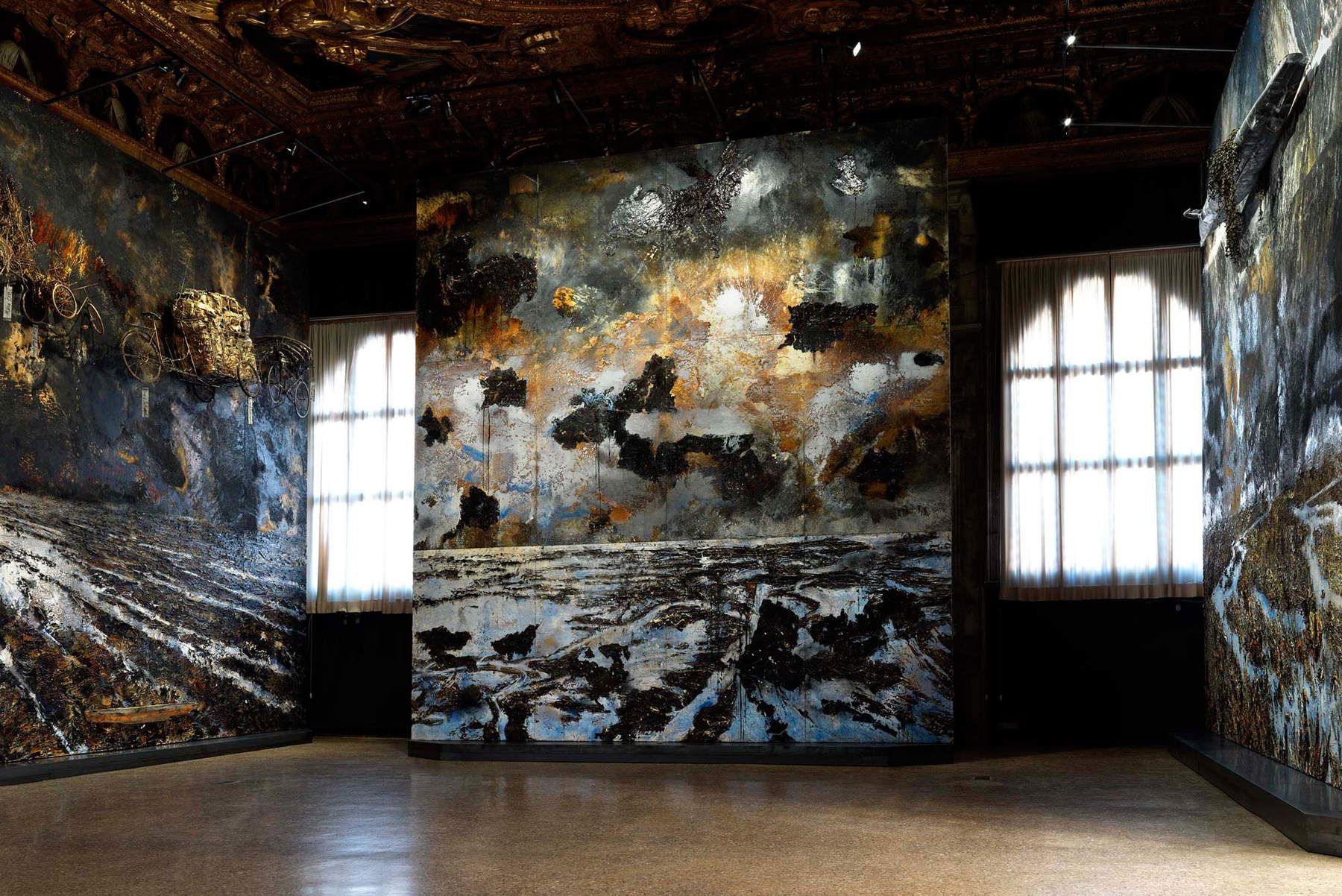

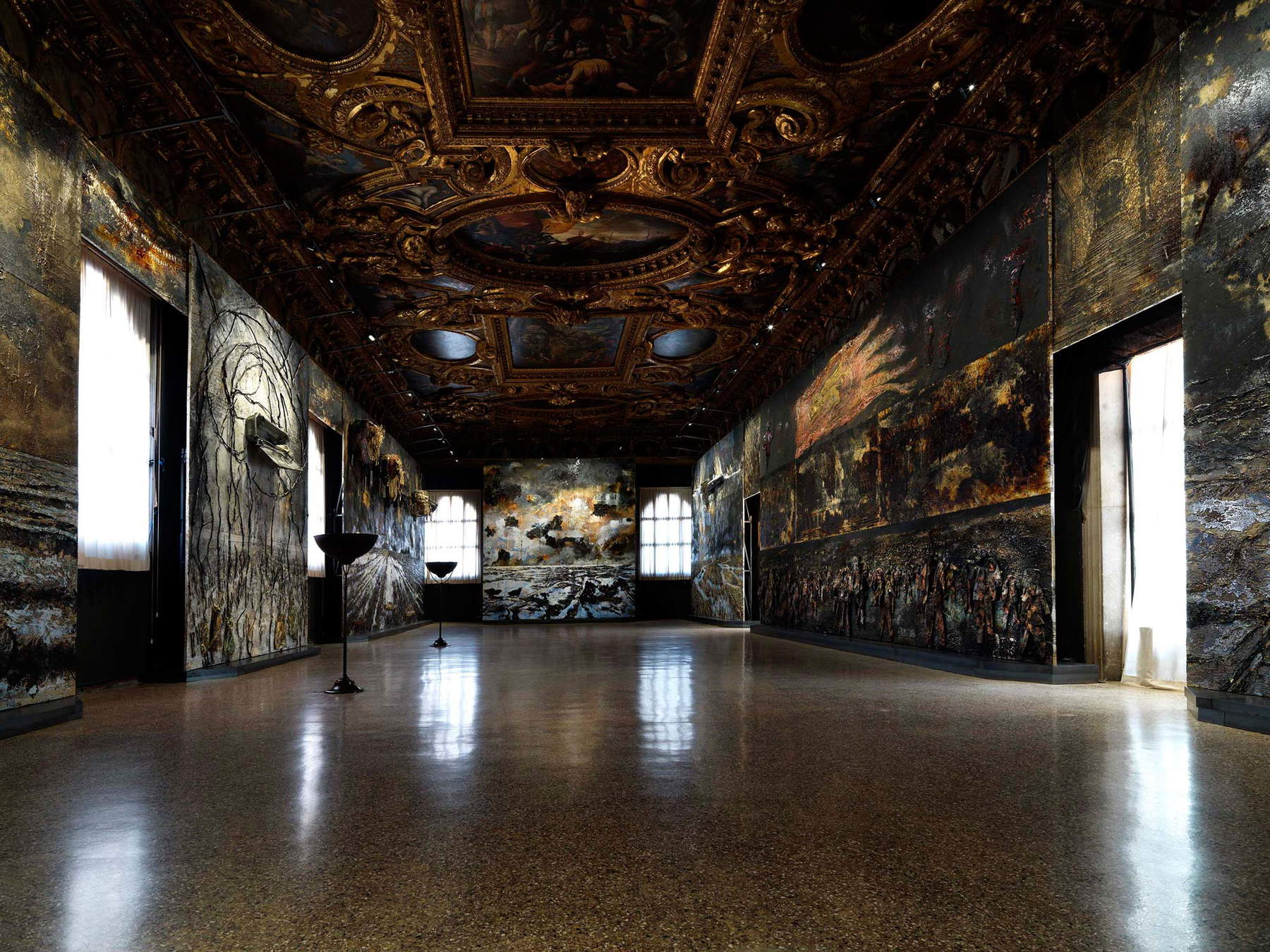
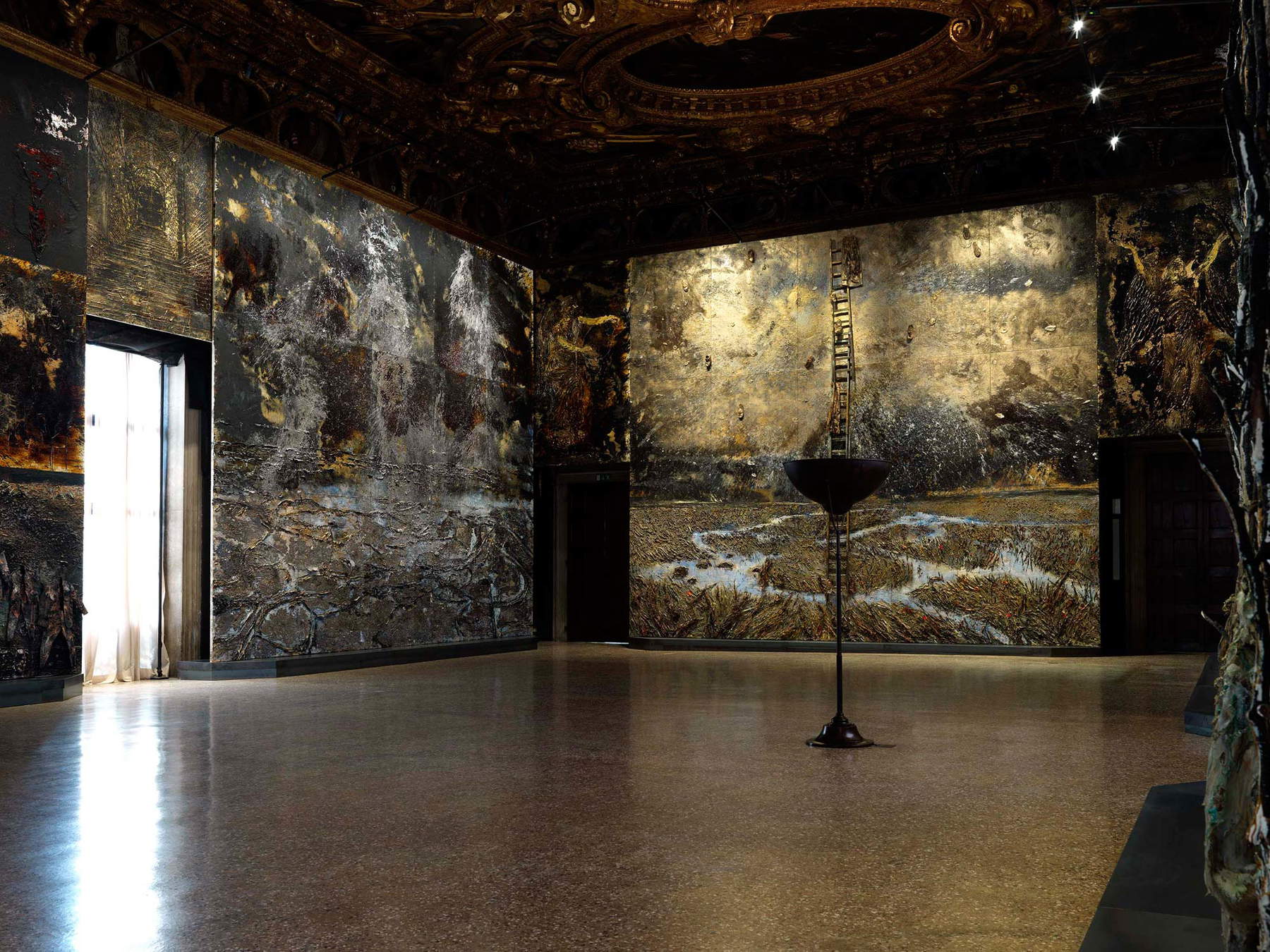
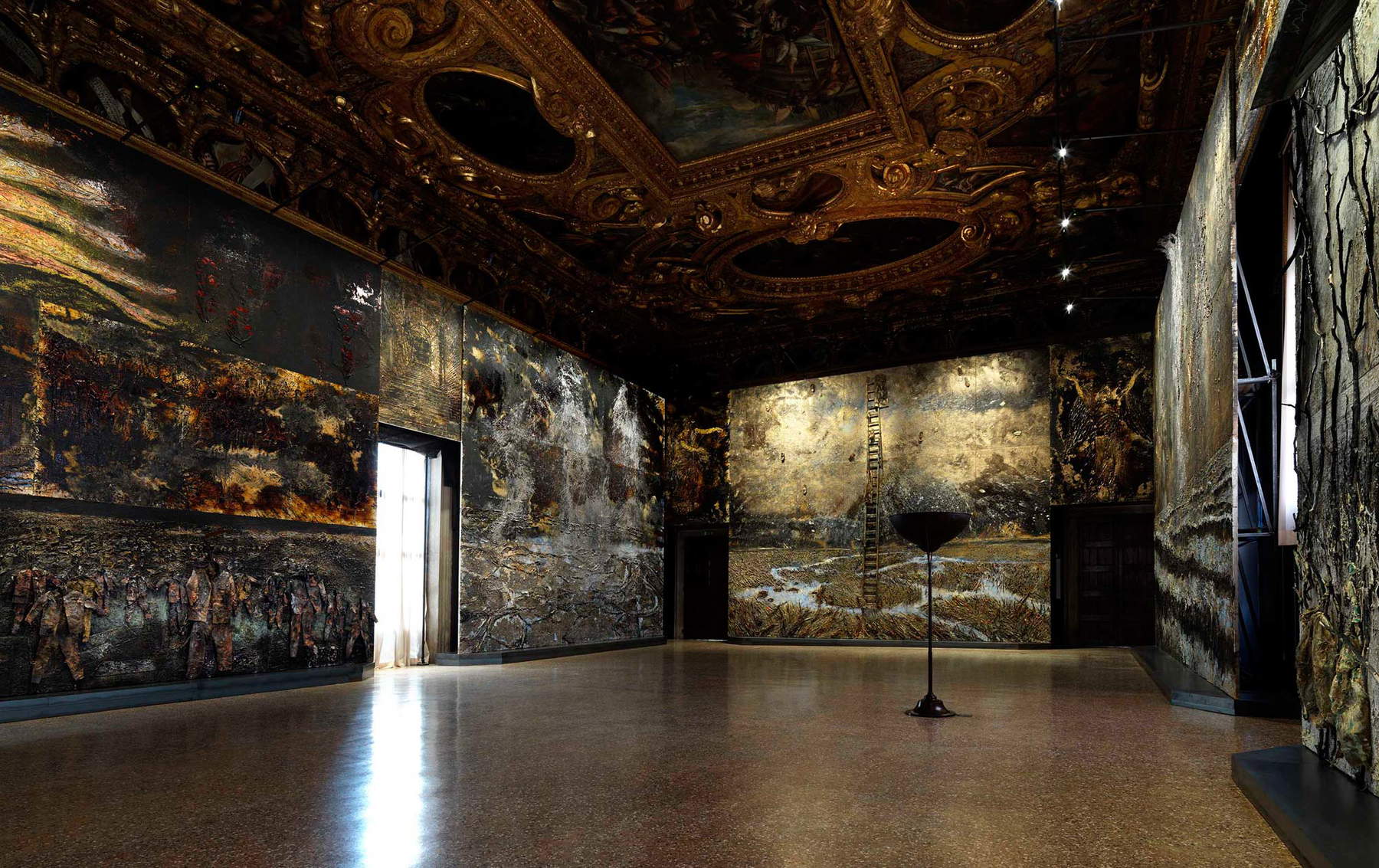
The most interesting aspect of the operation, however, concerns the reflection that the cycle imposes on us about the role that art should play with regard to the public. The facts: for six months, Kiefer’s work covers the paintings of the Sala dello Scrutinio, the room where in ancient times the electoral counts for the appointment of the doge were held. The decoration, executed by some of the leading artists active in Venice between the 16th and 17th centuries (Tintoretto, Palma il Giovane, Andrea Vicentino, Pietro Liberi, Pietro Bellotti, Antonio Aliense, Sante Peranda), recounts eight centuries of battles won by the Venetians from 809 until 1656. For six months, the public is not allowed to see them: the commission, namely the management of the Fondazione Musei Civici di Venezia, has peremptorily imposed Kiefer’s cycle. The presentation of the exhibition speaks of a “great challenge,” one that consisted on the one hand in “bringing back, albeit temporarily, after almost three hundred years,” painting to the halls of the Doge’s Palace, and on the other hand in working “alongside the great painters of the past called upon by the Senate of the Republic to repaint on the walls of the Sala dello Scrutinio, after the devastating fire of 1577, the glory of Venice, by sea and land.” But what is the challenge? Bringing works by one of the world’s most acclaimed artists to one of Italy’s most visited museums, traversed every day by hundreds of tourists who do not hesitate to pay a hefty ticket (30 euros the full) in order to admire the splendor of the Republic of Venice, is not a challenge: the result is easy, safe, guaranteed, taken for granted. A splendid showcase for Gagosian, one might add a little populistically: in fact, the public space (for such is the Doge’s Palace) becomes for six months a sort of extension of its gallery. It would then have been more challenging, and even more innovative, to bring Kiefer to Mestre. The great artist accepting the challenge of measuring himself against the periphery (and he would certainly have been capable of doing so), for to measure himself against Tintoretto and the Doge’s Palace does not require much: for an artist like Kiefer, presence is enough.
Secondly, it might be recalled that the Doge’s Palace is not a museum, or at least not in the meaning that dwells in the collective imagination, that of a collection of objects that, either at a precise moment or at several stages in history, composed a collection that is now shown to the public. Even if the logic of consumption of the Doge’s Palace is that of a musealized space (you queue to enter, you pay a ticket, there are signs explaining rooms and works of art, there are custodians and guides, you end your visit in a store where thematic books and souvenirs are for sale), the Doge’s Palace is not a museum: it is an ancient institutional seat that has remained virtually unchanged since the year Venice lost its independence. An untouched place. And one could then say, without fear of passing another thought that might be perceived as marked by some populist streak, that if that place has remained intact, then perhaps it should remain so, regardless of the fact that Kiefer’s intervention is temporary (although there is no shortage of occasional commentators on social media calling for the exhibition’s duration to be extended): if the Hall of Scrutiny has remained the same for three centuries, we would like to continue to be able to see the outcome of this conservation unhindered, especially since Kiefer has never made a secret of his love for Tintoretto, avowedly his favorite artist. If for a museum, where works are often moved all the time, an intervention such as Kiefer’s might be permissible (although even within museums there are many contexts that we can consider historicized), digestion becomes decidedly more tormented in the face of any entry into the halls of the Doge’s Palace, especially if the outcome interferes with the environments.
What then is the significance, rather than of the work itself, of having commissioned it? Is it possible that the Venice cycle activates some form of reflection on the meaning of “public art” as Salvatore Settis hopes when speaking about the exhibition in the pages of Engramma, asking whether art should reflect political or cultural concerns chosen by the commissioner, present itself as a sum of values, act as a manifesto? Or is it just yet another ephemeral stunt done to coincide with the Venice Biennale? Does the Venice cycle succeed in instilling in the public the need and urgency for the activity that Settis says is sorely lacking today, namely “stopping to think”? Setting aside for the moment considerations about the relevance (or irrelevance) of the visual artist within the public debate, arguably, under this lens, Kiefer’s work succeeds no more than Venice alone already does: that story of birth, splendor, and fall that Kiefer deploys on his eight panels is the same story that one breathes as one walks through the city, both by day, when the torrents of tourists who traverse it far and wide show the most genuine and unapologetically loquacious side of today’s Venice, as well as at night, when the voices wane and the shadows of its past inspire meditative attitudes as they reflect on that water where, Brodskij said, the future of Venice and its function in the universe are also imprinted.
Warning: the translation into English of the original Italian article was created using automatic tools. We undertake to review all articles, but we do not guarantee the total absence of inaccuracies in the translation due to the program. You can find the original by clicking on the ITA button. If you find any mistake,please contact us.